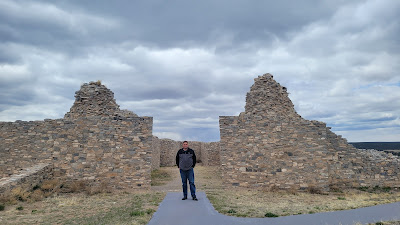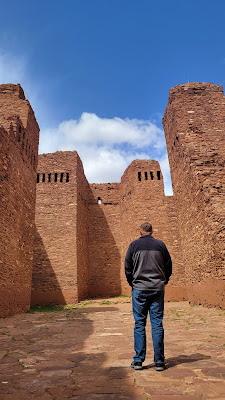Visited: April 2024
Nearby town: Mountainair, NM
In a remote, windswept valley along the Manzano Mountains of central New Mexico, lie the ruins of three missions built by the Spanish Franciscans in the early 17th century.
Salinas Pueblo Missions National Monument protects and preserves these ruins. The monument contains three distinct units: (1) Gran Quivira; (2) Quarai; and (3) Abo ruins. These 3 units are approximately 30 miles apart and the small village of Mountainair is the closest town.
In 1540, Spanish conquistador Francisco Coronado crossed the Manzano Mountains and came through this area during his famous expedition in search of "Cibola" - the legendary seven cities of gold - but no permanent Spanish settlements were built at that time.
Approximately eighty years later, in the 1620s, Franciscan friars came to this area on a missionary expedition, seeking to convert the native Ancestral Puebloans to Christianity (namely, Catholicism). They built three missions in this area, next to Puebloan villages along the salt trade route - dubbed the "Salinas" District by Spanish authorities. Salinas means "salt flats" or "salt mines."
The Franciscans' missionary efforts were largely successful. The exchange and interaction of the two cultures led to a relatively prosperous community. The missions served a significant religious, economic, and political function in Puebloan society in this region.
We visited all 3 units of this monument (this can easily be done in half-a-day). Our first stop was Gran Quivira, aka "Las Humanas." Gran Quivira was the largest mission and most populated village of the three (over 3,000 people lived here at its peak).
Gran Quivira is approximately 25 miles south of Mountainair and at an elevation of 6500 ft. These ruins were designated as a National Monument on November 1, 1909. The National Monument was expanded to include the other two units in 1980 (which had previously been managed by the New Mexico state government).
the Puebloan village at Gran Quivira
Looking at the ruins of the mission from the pueblos
These circular structures are known as kivas. Kivas served an important religious and cultural role in Ancestral Puebloan life before the arrival of the Spanish. The Franciscans initially attempted to ban kivas and the natives' religious rituals, but many Puebloans simply continued to use them (usually in secret). Eventually, a religious syncretism developed (wherein the Ancestral Puebloans combined aspects and traditions of their native religions with Christianity).
mission walls
kiva
This place was very remote, quiet, and interesting. We had the place to ourselves.
Next, we visited the Quarai ruins, about 5 miles to the north of Mountainair, and Abo, just west of town. The ruins of the missions at these two locations are more extant than at Gran Quivira and are very impressive.
kiva at Abo ruins
Abo was a major trading station at the time of the Franciscans' arrival
Quarai ruins. The walls of the mission at Quarai were 40-ft high and three to six feet thick.
the nave of the Quarai mission
Quarai ruins
Abo village/mission
kiva at Quarai
Although these communities were prosperous for a time, the missions (and the surrounding villages) were abandoned and deserted by the 1680s. This was largely due to a long period of drought and frequent attacks by Apache tribes.
This place is off the beaten path, but if you ever find yourself in this part of New Mexico it's worth a stop.
Learn more about these ruins and the people who lived here at the official NPS website:
Learn more about these ruins and the people who lived here at the official NPS website:

























.jpg)











































No comments:
Post a Comment